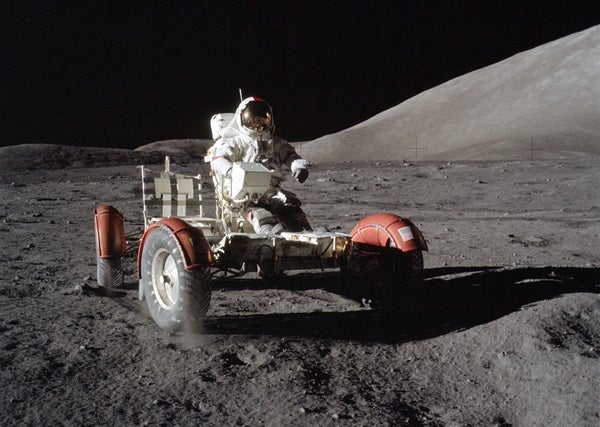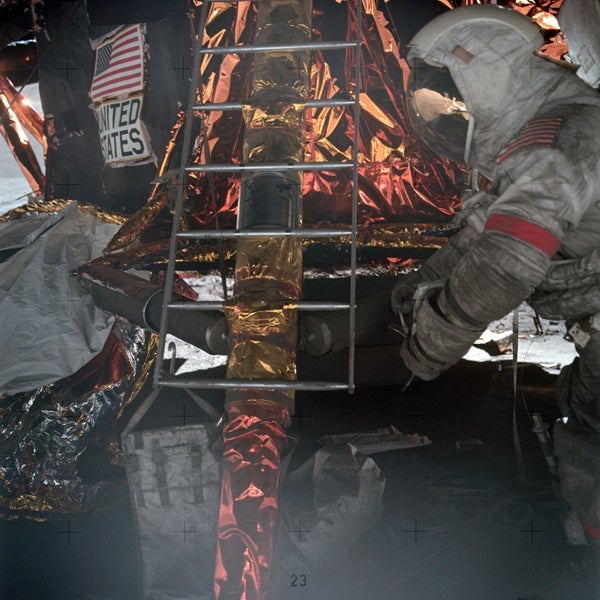Grimy, sweaty, and dust-streaked from the gray sand of the lunar desert, Apollo 17 Commander Gene Cernan looked every inch the explorer.
Fifty years ago, Cernan and Lunar Module Pilot Jack Schmitt spent three days on the Moon, making them the most recent human visitors to our nearest celestial neighbor. And beyond the triangular windows of the spider-like Lunar Module (LM), Challenger, lay the pristine lunar valley of Taurus-Littrow.
Peering outside, Cernan and Schmitt saw steep-sided mountains tumbling to a boulder-strewn, age-darkened valley floor. To their right, the North Massif rose higher than eight Eiffel Tower piled one atop the other. And to their left, the South Massif rose as tall as a half-dozen Empire State Buildings. Farther east, the dome-like Sculptured Hills — some more than a mile (1.6 kilometers) tall — offered a tease of ancient lunar volcanism. Meanwhile, the blue-and-white marble of Earth glittered in the velvet lunar sky, providing a reassuring reminder of home.
For those three days in December 1972, Taurus-Littrow was Cernan and Schmitt’s home.
A geologist’s dream: Taurus-Littrow valley
The Taurus-Littrow valley sits at the edge of the Moon’s Serenitatis basin, deep in the Taurus mountains and south of the eroded crater Littrow. When picked for Apollo 17’s landing, Taurus-Littrow was so far off the beaten track in terms of photographic coverage that nobody had even bothered to name it. But its double-barreled moniker has since earned notoriety, as this lunar valley is the last place visited by humans on another world.
Apollo 17 was a last-chance saloon for geologists seeking evidence of volcanism in the Moon’s infancy. Two Apollo missions had already been cancelled due to budget cuts. And President Richard Nixon, faced with an unwinnable war in Vietnam and social unrest at home, had little appetite for the spiraling costs of the lunar program championed by John F. Kennedy a decade earlier.
As Apollo 17 teetered on its own precipice of cancellation, one facet in the mission’s salvation was Schmitt: the first professional geologist to practice his craft on the Moon. Pressure from the scientific community saw Schmitt assigned to Apollo 17, joining Cernan and Command Module Pilot (CMP) Ron Evans. But as the crew trained, the managers fretted, for a failed mission might spell doom for NASA’s up-and-coming Space Shuttle Program.
One day, legendary flight director Chris Kraft pulled Cernan aside. “Geno, put away that fighter pilot’s silk scarf and just bring your crew home alive,” Kraft cautioned. “If you run into something you don’t like out there, and decide not to land, I’ll back you 100 percent.”
Landing on the Moon is hard enough. But getting there was equally taxing. Months before launch, Cernan suffered a prostate infection, which was treated by flight surgeon Chuck LaPinta. Then, during a softball game, something snapped in his right leg. Fears of a ruptured tendon proved unfounded, but LaPinta discreetly shielded Cernan’s recovery from wary managers who might have grounded him due to the injury. LaPinta, Cernan wrote, was “a great doctor, a terrific liar and an even better friend.”
Cernan, Evans, and Schmitt roared aloft from Pad 39A at Florida’s Kennedy Space Center (KSC) at 12:33 A.M. EST on Dec. 7, 1972, making them the first U.S. astronauts to launch at night. This enabled Apollo 17 to reach the Moon in the early lunar morning, with the Sun providing adequate shadows and good visibility over Taurus-Littrow.
“It’s lighting up the sky,” cried NASA commentator Jack King, as the Saturn V rocket powered uphill. “It’s just like daylight here at the Kennedy Space Center!”
Apollo 17: A final dance
The four-day transit to the Moon was uneventful. And on Dec. 11, Cernan and Schmitt boarded Challenger and undocked from Evans, who would remain in lunar orbit aboard the Command Module (CM), America. Descending like an express elevator between the forbidding lunar mountains, Challenger swept into the Taurus-Littrow valley at its eastern entrance and landed on sure ground at 2:54 P.M. EST.
For the next 75 hours, Cernan and Schmitt were the Moon’s only living occupants. Each of their three moonwalks exceeded seven hours. They drove a cumulative 22 miles (35 kilometers) in the battery-powered Lunar Roving Vehicle (LRV) and gathered 254 pounds (155 kilograms) of rock and soil specimens, the largest haul of any Apollo crew.
Setting foot on alien soil, Cernan compared the oddness of the Moon’s one-sixth gravity to walking on a bowl of Jello-O. Moonwalking and lunar dust’s abrasive clinginess proved dirty work: Within minutes, both men’s pure-white spacesuits were black from the knees down.
They unpacked the LRV from Challenger’s descent stage — eliciting a hearty “Hallelujah!” from Cernan — then test-drove it. And the glint of Earth, hanging like a dainty Christmas ornament over the South Massif, proved captivating.
Cernan called for Schmitt to look at their home planet, an iridescence of life in a sea of darkness: “Just look up there!”
“Ah,” drawled Schmitt, feigning disgust. “You seen one Earth, you’ve seen ’em all!”
Moving briskly, they set up the U.S. flag. Next was the Apollo Lunar Surface Experiments Package (ALSEP), a station of instruments used to explore the Moon’s environment and interior. They then bored holes into the lunar surface for a heat-flow study, which was physically strenuous work that left Cernan’s fingers bruised and bloodied.
The next morning, having awakened to Wagner’s Ride of the Valkyries, courtesy of Mission Control, the astronauts hopped down Challenger’s ladder for the second moonwalk. A broken fender on one of the LRV’s wheels — which had earlier sprayed rooster-tails of dust over the astronauts — was fixed with clamps and four maps taped together. Cernan and Schmitt headed for the South Massif, sampling boulders and inspecting craters Lara, Camelot, and trough-like Nansen, the latter of which reminded Schmitt of Alpine valleys on Earth.
But it was the 360-foot-wide (110-meter) Shorty Crater that yielded Apollo 17’s biggest surprise. Dark-rimmed with blocky interior walls, Shorty’s ubiquitous grayness was broken by the merest hint of orange. Schmitt thought his eyes were tricking him, but he was indeed seeing orange soil, a tantalizing hint of ancient volcanism. Cernan took a core sample, which turned out to be red along part of its length, before fading to purplish-black. Today, the Shorty soil is thought to have derived from rapidly cooled molten rock.
Leaving the Moon for the next 50 years
Cernan and Schmitt’s final moonwalk took in Sherlock Crater, swung past Turning Point Rock, then headed over the lower flanks of the North Massif. They completed one last sampling stop at the Sculptured Hills. But with oxygen supplies dwindling, the clock was forever their enemy on the Moon.
The ‘lastness’ of Apollo 17 was readily apparent to Cernan as he took his final steps on the surface. “America’s challenge of today has forged man’s destiny of tomorrow,” he said before climbing up Challenger’s ladder. “And as we leave the Moon at Taurus-Littrow, we leave as we came, and God-willing, as we shall return: with peace and hope for all mankind.”
A few hours later, Challenger headed back to lunar orbit to dock with America. An excited Evans had spent three solo days running the Scientific Instrument Bay (SIMBay) of cameras and sensors on America. The work proved so exhausting that one morning he overslept by an hour, despite Mission Control’s continued efforts to wake him. Evans also set a record for the longest time (147 hours) spent circling the Moon.
After 75 lunar orbits, Apollo 17 headed back to Earth. On the homeward-bound journey, Evans performed a 65-minute spacewalk to retrieve SIMBay film cassettes. His excitement was readily apparent in his first words as a spacewalker: “Hot diggety dog!”
Three days later, America splashed down in the Pacific Ocean, close to the recovery ship, Ticonderoga, wrapping up what would be the 20th century’s last human visit to the Moon.
For five decades, Taurus-Littrow, peppered with boot prints and LRV tire-tracks, and littered with remnants of a fleeting, long-ago human presence, remains the most recent human outpost on the Moon. Cernan and Evans are now gone. But the shared hope of Apollo 17 that we will someday return to this enticing gray-tan world has drawn inexorably nearer.











